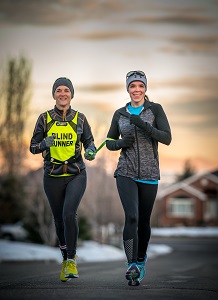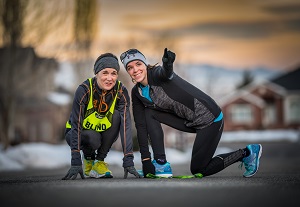Becky Andrews has lost her sight, and Alanna Whetsel will slowly lose hers.
But the two Utah women have never lost sight of their shared goal of running the Boston Marathon together. On Monday, April 16, as they have done on countless early morning training sessions, Whetsel will wrap a short tether to her arm and Andrews will hold on to it as they navigate the famed 26-mile course through that historic city.
"We are beyond excited," said Andrews. "I think the way we have been there for each other is pretty special. We've run other half marathons and marathons together, but running Boston together will be the icing on the cake."
Andrews, now 53, was diagnosed with retinitis pigmentosa (RP) when she was 18 years old. A group of rare, genetic disorders, RP involves a breakdown and loss of cells in the retina the light-sensitive tissue that lines the back of the eye. It starts with night blindness and eventually leads to tunnel vision. Today, her vision is reduced to a small, fuzzy peep hole in one eye.
While pursuing a degree in counseling, Andrews worked in the Patient Support Program at the John A. Moran Eye Center, encouraging patients who were adjusting to vision loss. She went on to earn two master's degrees and launch a counseling practice with her husband all while raising a family. She's on her third beloved guide dog and, in addition to running, she's ridden thousands of miles with her husband on a ta ndem bike. Not surprisingly, their practice is named "Resilient Solutions."
ndem bike. Not surprisingly, their practice is named "Resilient Solutions."
Andrews' story and optimism turned out to be a lifeline for Whetsel after the 39-year-old young mother of four received a surprise diagnoses of Stargardt disease during a regular eye exam a couple of years ago. Stargardt is another inherited disease of the retina a rare form of macular degeneration. It typically causes central vision loss and progresses slowly, over time to 20/200, or worse (normal vision is 20/20). The "good news" is that peripheral vision may be maintained.
Though Whetsel's vision is now 20/25 in one eye and 20/35 in the other and she reads and drives, she will eventually become legally blind.
"After the shock of my diagnosis, I went home and tried to memorize my kids' faces," she said. "And I cried a lot."
Paul Bernstein, MD, PhD, Alanna's ophthalmologist and a researcher at the Moran Eye Center referred her to a genetic counselor. The counselor, familiar with Andrews' story, suggested the two get together.
"Alanna sent me the sweetest email, told me her story, and said she would love to connect," Andrews recalled. "The first time we met, we shared and commiserated, and really sparked. The next time we got together, we got past our vision issues and realized we shared a love of running. So I told her if she would be my guide, I'd run with her. We started with a half marathon, then full marathons, and qualifying for Boston."
"We are proof that if you really want to do something, the desire to do it can overcome the fear," Andrews said. "I admire how Alanna reached out when she was hit with the unknown. Certainly I've fallen and tripped and had to navigate obstacles. But you fall, and you get back up."